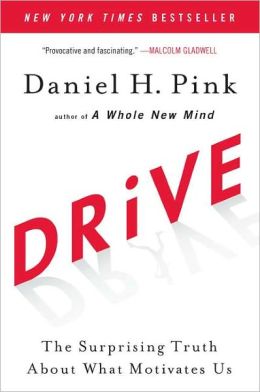Pink’s challenge to action falls short in “Drive”

Photo courtesy of bn.com.
September 4, 2013
Motivation is what wakes us in the morning. It is what gives us the energy to try and take risks, and what keeps us going on a daily basis. But according to Daniel Pink’s 2011 bestseller, “Drive,” the motivation that we’ve been using just isn’t enough.
“Drive: The Surprising Truth About What Motivates Us,” the One Book of the 2013-2014 school year, offers an explorative look into the benefits of intrinsic motivation while synthesizing a new way to enhance creativity in the modern world.
Pink writes that “Motivation 2.0,” a system of benefits and rewards, is outdated, and that there is a need for “Motivation 3.0” in which individuals strive towards autonomy, mastery and purpose and in doing so become far more productive than their 2.0 counterparts.
The book itself, though, only takes up about half of the overall content, making reading “Drive” no lengthy endeavor. Those core chapters cover in depth exactly how and why Motivation 2.0 has become outdated, and what steps need to be taken in the future.
However, despite Pink’s fastidious intentions, with every labeled section I came to, I became less and less interested in his premise. Pink offers example after example that all prove the same point, and doesn’t seem to realize that even by the end of the first chapter, there is already a clear formula to his prose.
The second half of the novel, on the other hand, is an appendix—or a “toolkit,” as Pink calls it—that is there to help us defeat Motivation 2.0 in our daily lives. The toolkit helps in that it demonstrates the wide variety of fields Motivation 3.0 can be applied to, however, there was no material there that is anything new or shocking.
On the upside, the writing style of “Drive” is humorous, eloquent and straightforward, while the text itself is atypically short for non-fiction bestsellers, making it the perfect length for some summer reading.
However, with that said, as a reader who has both watched Pink’s 20-minute TED talk and listened to him in person for another hour-long speech, his book includes little I had not heard from him before and that I had not already agreed with, in a even more compact version.
Pink may offer a concise accumulation of information that counters centuries of conventional thought, but to an individual reading “Drive,” his reflections at best resonate briefly, and offer few to no new revelations about how to implement the 3.0 system. Despite it’s promising start, for a book about motivation, “Drive” requires far too much of that selfsame quality just to reach its back cover.





![A group of juniors play “Clash Royale” on their phones during lunch. Lunch is the only time when phones are allowed to be out. “I think once we adapt to it, it's not going to be something we miss because [for] everyone moving forward, that'll have been the policy [since] middle school,” DNA science and biology teacher Aubrie Holman said.](https://www.tjtoday.org/wp-content/uploads/2025/09/IMG_6621-2-e1758016994220-300x239.jpeg)